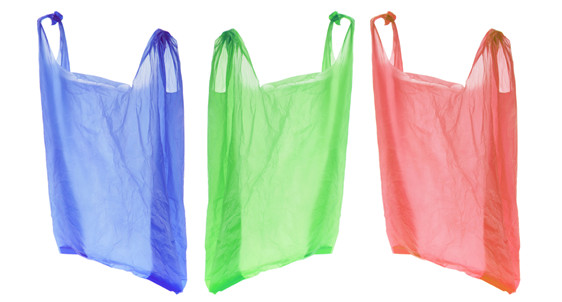
What Are the 5 Most Common Types of Plastic Bags?
Other than size, shape, color and other physical characteristics, plastic bags are available in various materials that offer their own benefits and features. How can you make the right choice? You need to start by familiarizing yourself with the most common type of plastic used by plastic bag manufacturers, i.e. polyethylene.
Let’s look at the 5 types of poly plastic bags typically used today:
1. HDPE – HDPE stands for High Density Polyethylene, which is the most common material used to create plastic shopping bags. The polymer material used for these bags is made with straight molecule chains that have a linear structure from start to finish, with very little branching. As a result of the dense molecular structure, plastic bags made with HDPE are moderately opaque and lightweight but extremely sturdy.
Thanks to their high tensile strength, HDPE bags can hold many times their own weight without falling apart. They are also highly resistant to chemicals, water and temperature, relatively transparent, and food-safe. HDPE is used in the production of T-shirt bags, utility bags, laundry bags, garbage bags, and food handling/serving/packaging applications where an oxygen or CO2 barrier is not required.
2. LDPE – LDPE stands for Low Density Polyethylene, which is a common type of plastic used in food packaging as well as utility bags. The polymer material used for these plastic bags is made with polyethylene chains that have a low density and spread out in various combining lines or branches. As a result, LDPE plastic is very lightweight and has moderate tensile strength.
While not as strong or stretchable as HDPE bags, its low melting point makes it ideal for use in heat-sealing applications. In addition, its film-like transparency makes the identification of contents easier. LDPE bags are often the packaging material of choice for restaurants and other commercial food handling operations, produce and meat suppliers, dry cleaners, etc.
3. LLDPE – LLDPE stands for Linear Low Density Polyethylene, which is commonly used in the production of plastic shopping bags as well as food bags, garbage bags and newspaper bags. While also made with polymer materials that have non-branching polyethylene chains, they do not have the same tensile strength as HDPE bags and need to be manufactured in a thicker and heavier form for shopping bags.
However, LLDPE bags do have moderate clarity and a slightly lower gauge than LDPE bags, without any difference in strength. This makes them a cost-effective alternative to LDPE for bulk food storage/packaging and other applications where quality is critical. They are particularly well-suited for freezer or refrigerator storage in commercial kitchens, but popular with clothing stores too.
4. MDPE – MDPE stands for Medium Density Polyethylene, which is a combination of high-density and low-density polyethylene. MDPE is not as clear as LDPE, but it’s not as opaque as HDPE either. This polymer is less dense than HDPE, so it isn’t as strong and does not make a good choice for bulk storage or transportation. However, it has a high degree of chemical resistance.
Due to its comparatively low tensile strength and stretch properties, this material may not be ideal for the manufacture of plastic shopping bags, but it can be used in the production of garbage bags, shrink film and packaging film for certain consumer products, such as paper towels, toilet rolls, etc.
5. PP – PP stands for Polypropylene, and this material has very high chemical resistance and strength as well as a high melting point, which makes it ideal for hot fill liquid or food packaging applications. Compared to other poly plastic bags, polypropylene bags are also less opaque and allow for easier identification of their contents.
PP bags are quite common in retail operations as well, since they are food-safe, not breathable and have a longer shelf life than most other types of polyethylene bags. They are generally used to store products such as ketchup, yoghurt, syrups, candies, baked goods, medicines, etc., which have water, salt or acids that may damage metal and other packaging materials.
When you’re trying to choose the right type of plastic bag making machine for your business needs, understanding your options will help you narrow it down!
Author Bio: Mohan Naik oversees the digital marketing for one of the leading name in the field of plastic converting machinery. On a mission to help entrepreneurs make a high quality choice that delivers value, he efficiently turns even the most technical topics into interesting and engaging content that even a layman can comprehend. He writes to educate his audience and skillfully uses marketing to incite interest even in the most passive of readers. He stays updated with the latest trends and innovations in the industry and is quick to share that with his readers.
Hygiene Links is a UAE based leading manufacturers, importers & exporters of cleaning products.
5yHi, ya, you right! there are many types of plastic bags are available.. if you want to see more types of plastic bags like **** Plastic Shopping Bags **** **** Garbage Bags **** **** Laundry Bags**** **** Biohazard Bags **** ****Poly bags**** **** Biodegradable Bags **** http://www.superplasts.com/